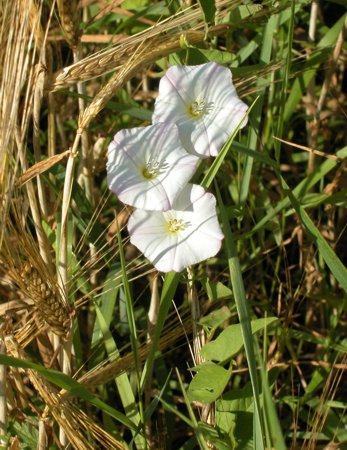Weeds
Convolvulus arvensis L. - Field Bindweed
Systematic position.
Family Convolvulaceae, genus Convolvulus L.Biological group.
Perennial offset weed.Morphology and biology.
The stalks are 20-100 cm long, thin, climbing or prostrate along ground, glabrous or with scattered thin hairs at top. Leaves dark green, petiolate, elongate-lanceolate, cordate at base, glabrous or with scattered short hairs. It has 1-3 flowers located on axillary pedicles that are mostly longer than leaves. The sepals are 4-6 mm long, oblong, emarginated at top, having small pointed apex, glabrous or only sometimes ciliated along margins. Corolla is 15-26 mm long, funnel-shaped, with five longitudinal folds, pink, seldom white, glabrous or with two rows of hairs in upper part; there are five stamens; ovary with one column and two threadlike stigmas. Fruit is a bilocular 4-valved and 4-seeded boll, about 6-7 mm long, rounded-ovoid, smooth, pointed upward, glabrous. Seeds ovoid, triquetrous, rough, dark gray or brown, covered with small tubercles. Field Bindweed blossoms beginning in the second year of its life, from the end of May until September. Seeds ripen during grain harvesting, partly dropping and littering ground; the significant part gets into grain yield. Reproduction occurs by root shoots and by seeds. Maximum fruitfulness is 9800 seeds; seed viability is up to 50 years. Minimum temperature for germination of seeds is +4-6°C and optimum is +18-24°C. Period of seed germination is prolonged; maximum depth of germination is 10 cm. Shoots appear in late spring. In autumn the roots reach depths of 100-120 cm, forming buds that produce new leaf-bearing shoots in spring. Adult plant develops thick root system. Main stalk root reaches a depth of 3 m, developing plenty of lateral roots (offshoots) that bear buds. The main root cut during autumn plowing at depths of 25-27 cm gives some offshoots the next year.Distribution.
The plant is almost cosmopolitan. The European part of the former USSR, the Caucasus, Western and Eastern Siberia, the Far East, Central Asia, Western Europe, Asia, Northern Africa, Northern and South America.Ecology.
This species occurs in crops, fallow lands, along roads, on waste grounds, in gardens, on slopes devoid of vegetation. This is a drought-resistant plant.Economic significance.
Litters grain and ground. It is a pernicious weed for all cultures. Powerful branching stalks covered with thick leaves twist cultivated plants, causing their lodging. It reduces grain yield by 30-50%. Economic threshold is 5-8 plants per sq. m. Control measures include double plowing-in of stubble at the depth of 10-12 cm and 12-15 cm and subsequent deep plowing-in by a plow with colter at the depth of 27-30 cm; one of the main agronomical methods of struggle against Field Bindweed is 3-4-times repeat cutting of the main root by moldboard jointer at depths of 10-14 cm (stubbling in clean or occupied fallow after harvest is preferable); cleaning of sowing material, mowing at boundaries, chemical weeding are also recommended. Young plants are easily destroyed with soil treatment; it is more difficult to eradicate old plants. Cutting results in the exhaustion of nutrients in the root system and leads to the destruction of the latter. Fodder cereals are recommended in crop rotations.Reference citations
Keller B.A., Lyubimenko V.N., Maltsev A.I., Fedchenko B.A., Shishkin B.K., Rodzevich R.Yu., Kamenskii K.V., eds. 1934. Weed plants of the USSR. V. 3. Moscow-Leningrad: AS USSR. 448 pp. (In Russian)Shishkin, B.K., ed. 1953. Flora of the USSR. V. 19. Moscow-Leningrad: AN SSSR. 752 p. (In Russian)
Skorokhod V. 1951. Weeds of Donets Basin and their control. Makeevka: Stalin Publishing House. 72 pp. (In Russian)
Tanskii V.I., Levitin M.M., Ishkova T.I., Kondratenko V.I. 1998. Phytosanitary diagnostics in integrated management of cereals. In: Novozhilov K.V., ed. Compendium of methodical recommendations in plant protection. St. Petersburg: VIZR. 5-55 p. (In Russian)
Tikhonova Z.E. 1937. Weeds and their control. Gor`kii: Gor`kii Regional Publishing House. 90 p. (In Russian)


